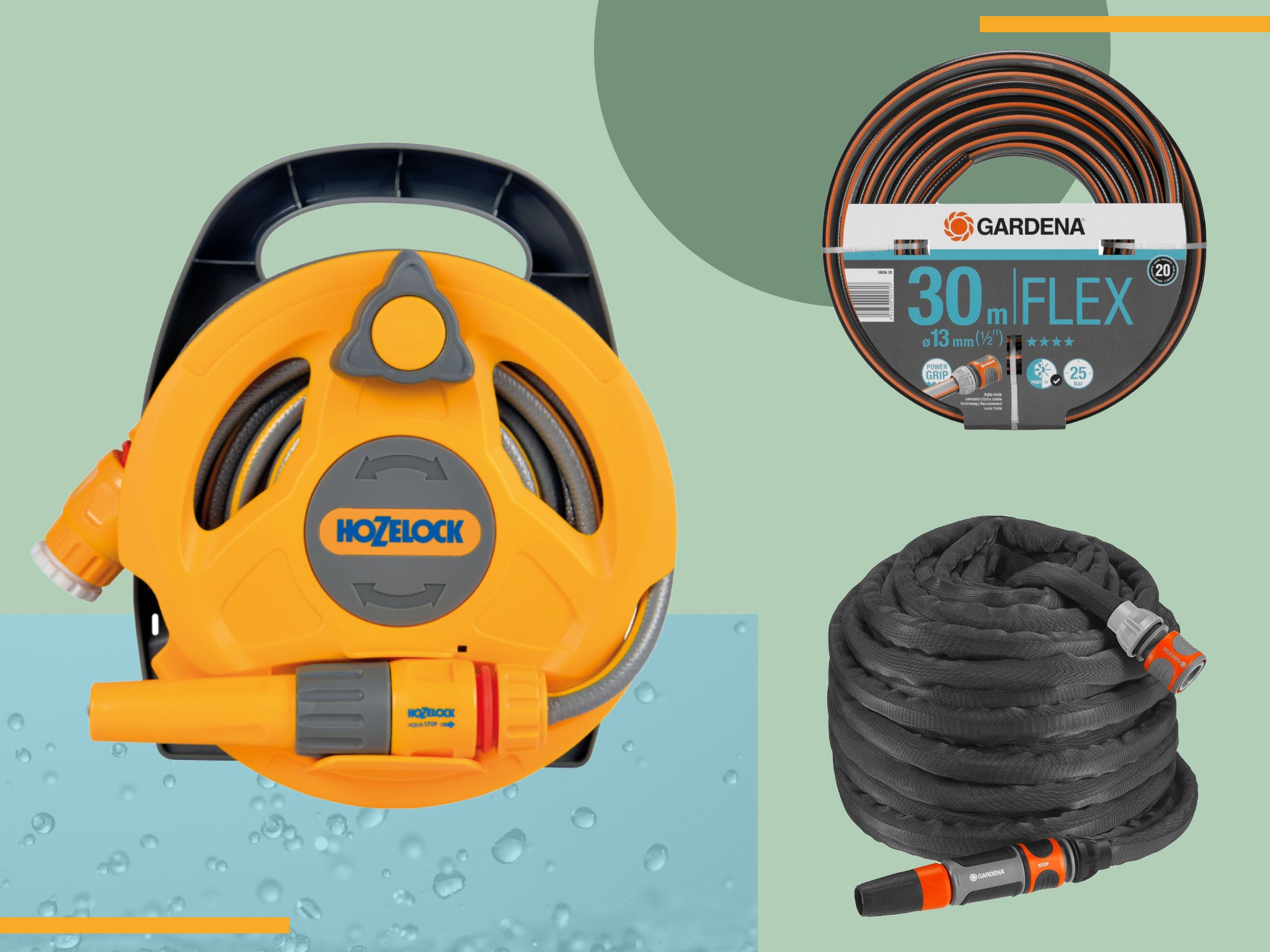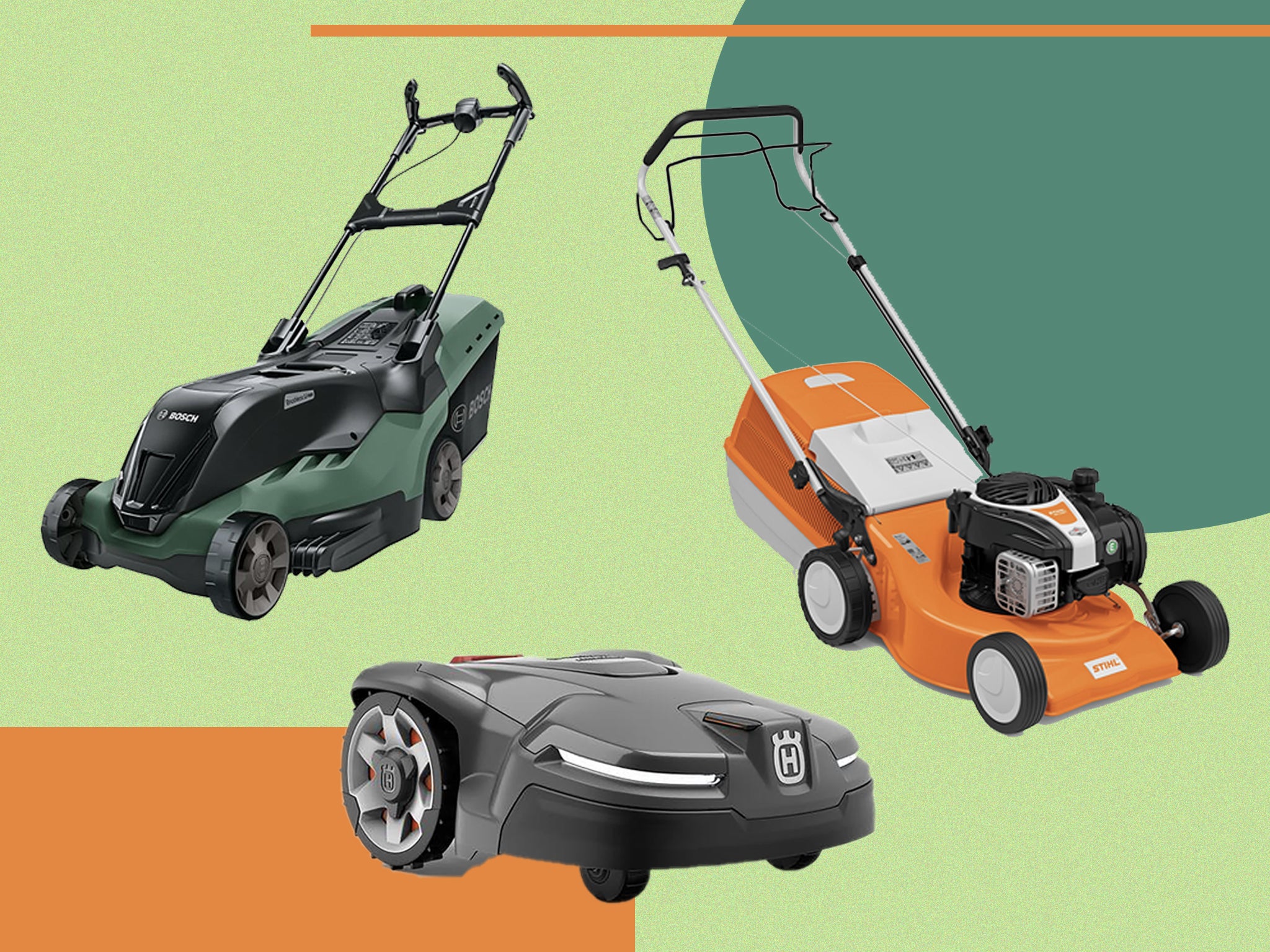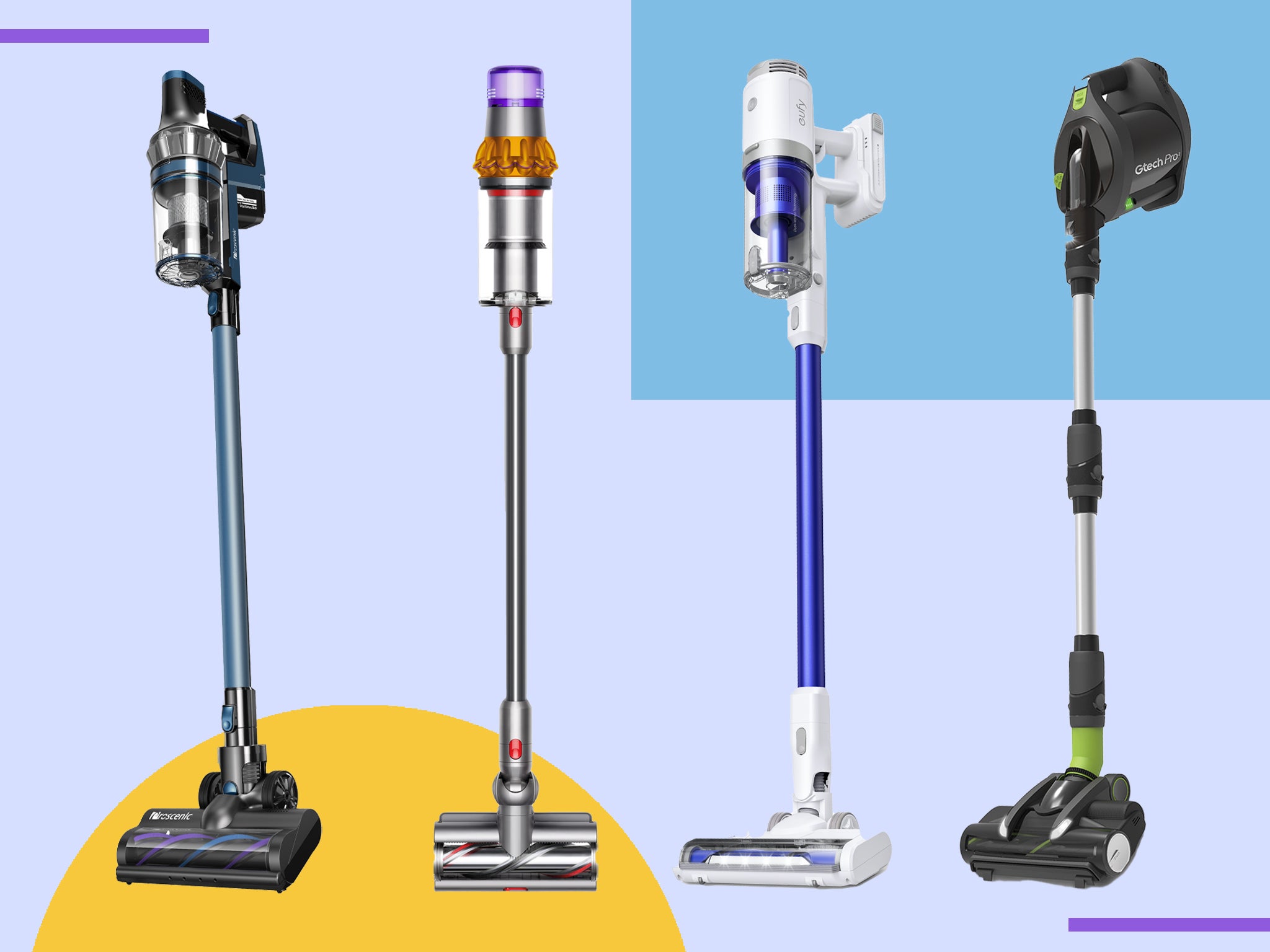
The Independent's journalism is supported by our readers. When you purchase through links on our site, we may earn commission. Why trust us?
10 best pressure washers to get cars, bikes and garden furniture looking spotless
Blast through stubborn mud, mildew and stains in seconds with these powerful pressure washers
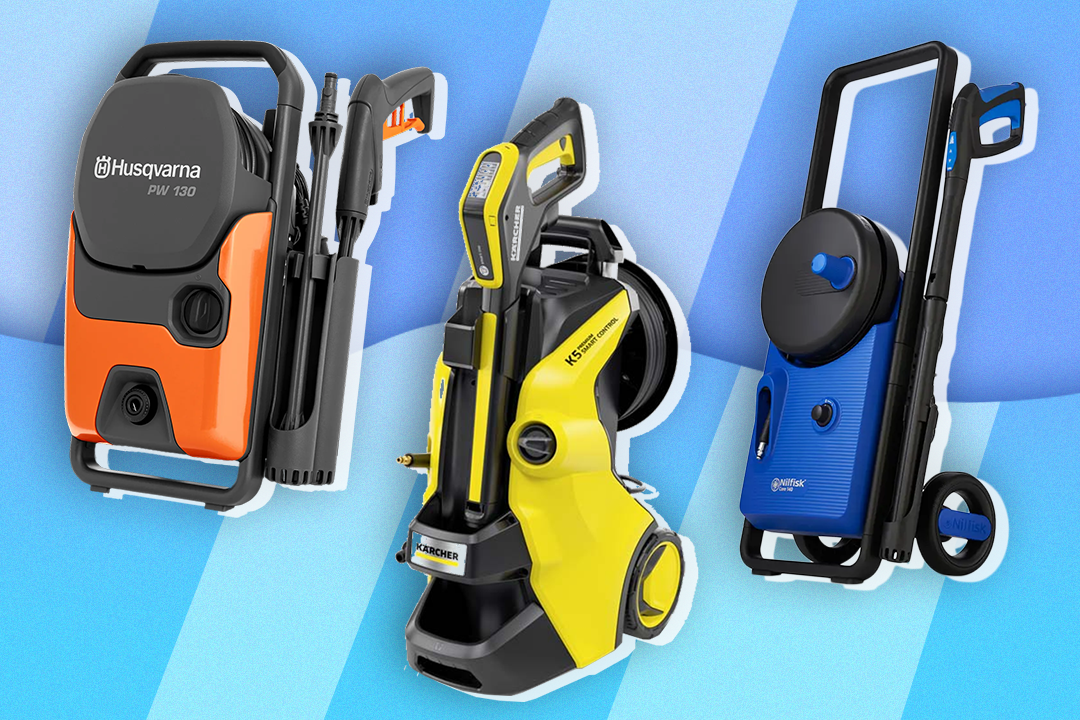
Grime, gunk, algae, fungus, mould, mud, moss and mildew. Not members of an ageing punk band from the Seventies, but the kind of stuff that covers exterior surfaces after a hard winter of rain, damp and very little sun.
Obviously, to get rid, there’s only one machine for the job – the pressure washer. And now that spring is here, you’re probably waking up at the weekend to that familiar sound (the steady drone from the motor and fizz from the water jet) of an army of washers being put to work.
Importantly, how powerful the jet of water is (pressure) is measured in bar, while how much water exits the nozzle every minute (flow rate) is measured in litres per hour (l/h). Together they will give you a very accurate overview of how capable the machine is of coping with a range of weekend projects from cleaning garden furniture to freshening up an entire driveway.
Apart from overall performance, you need good build quality as washers can take quite a beating, as they’re constantly on the move over driveways, patios, decking and other hard surfaces. Also, because there’s always plenty of hose and cabling involved there needs to be a good management system in place so you don’t end up doing battle with it all as you work, trying to unkink hoses and extricate yourself from tangled power cords.
There’s a huge range of machines ranging from sub to several hundred pounds. The trick is matching the washer to your external task list, which is why we’ve categorised each washer that made our edit, so you can ensure you’re getting the right one for your workload.
How we tested
The good thing about testing pressure washers is that we get to tackle our rather intimidating list of outdoor cleaning jobs that sits waiting for us after winter hibernation. From algae-covered decking to cars with “clean me” graffitied in mud, we pitted each machine against the familiar range of tasks that face UK homeowners, as they begin to venture into the light and get their outside settings ready for warmer days.
We had 12m x 16m of decking to play with, and so we gave each machine one 12m board to clean so that we could compare results. Increasingly, washers are shipping with more and more attachments to increase their applications and we’ve tried all of them. After working our way through the testing criteria with each machine we were left with the real workhorses we’re happy to recommend, oh, and a very clean house too.
The best pressure washers for 2024 are:
- Best overall – Husqvarna PW 130: £131, Forestandarb.com
- Best budget pressure washer – Nilfisk C140: £187.04, Amazon.co.uk
- Best for the car – Karcher K5 power control car & home: £389.99, Amazon.co.uk
- Best for bikes – Muc-Off pressure washer starter kit: £127.98, Amazon.co.uk
Husqvarna PW 130

- Best: Overall
- Hose line length: 6m
- Max pressure: 130bar
- Flow rate : 465l/h
- Power cable : 5m
- Weight : 6.5kg
- Attachments : Foam sprayer
Husqvarna has done a very good job at packing a lot of functionality into this lightweight washer, from a foam sprayer to variable flat jet and rotary nozzles which increases the overall versatility of the machine. The foam sprayer was very efficient for surface cleaning jobs while the other nozzles deal with the trickier cleaning tasks with the pressure adjusted by simply twisting the nozzle heads. On the top of the machine is a quick-look, intuitive guide that will tell you what nozzle and pressure level is needed for cars, fences and bikes.
The comfortable carry handle added to the portability of the machine, while the gun and lance are both stored neatly away, while the hose detaches completely and is stored in a purpose-built compartment. The power cord is wound around a central hub and kept in pace by a hard-wearing, rubber fastener. This is a well thought through washer that won’t disappoint in terms of its performance or price.
Karcher K7 premium smart control
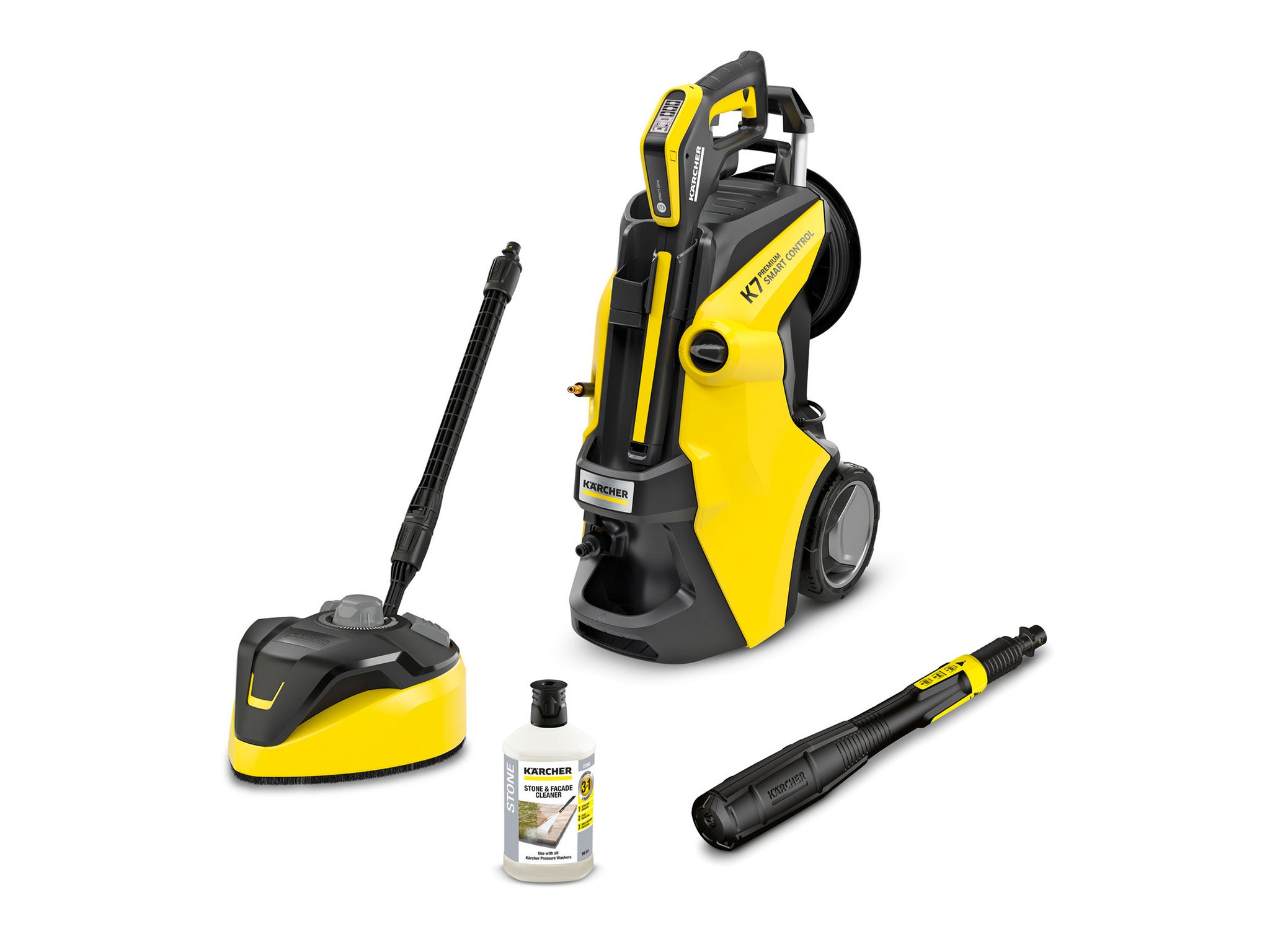
- Best: For long garden to do lists
- Hose line length: 10m
- Max pressure : 180bar
- Flow rate : 550l/h
- Power cable: 5m
- Weight: 17.8kg
- Attachments : T7 surface cleaner; stone and façade cleaner
The first question we asked ourselves as we unpacked the German brand’s flagship product was, “do we really need our pressure washer to be smart?”. The QR code that presented itself to us on opening the box, telling us to scan the code and download the app before doing anything else, seemed to imply that Karcher definitely think so.
The app helps set up the machine and allows you to choose one of nine different cleaning targets, after which it will show you what pressure level you need the water to run at, which of the three spray settings you need to twist the lance around to and then how many more steps you’ve got to follow before your job’s done. This is all very helpful, except the machine is so versatile and user-friendly on its own that it won’t take you long to figure out exactly what you need, to complete your job with the minimum of effort and its controls are so intuitive you can do it all on the fly without having to waste time consulting the app.
The K7 is one of those “they’ve thought of everything” products from the fact that the casing has been designed to store and transport multiple accessories, saving you multiple trips back to the garage, to the control you have over the entire machine (and your clean) from the handle of the gun. Simply using the plus and minus buttons you’re able to adjust the pressure between a minimum of 20bar and a maximum of 180bar over six settings.
In addition, you can adjust the spray by turning the lance to one of three settings: flat jet, dirt grinder or detergent. Holding down the plus button activates boost mode, regardless of what setting you were using, which increases the pressure level for 30 seconds if you encounter a particularly sticky or dirty patch.
The dropped points only come from the fact that it is noisy and quite an unwieldy, heavy piece of kit to get around, but then it has to be when it comes bristling with so many accessories and such a big motor to power the maximum pressure. Also, the fact that you’re paying for it to be app-enabled when, in our humble opinion, it really doesn’t need to be.
Nilfisk C140
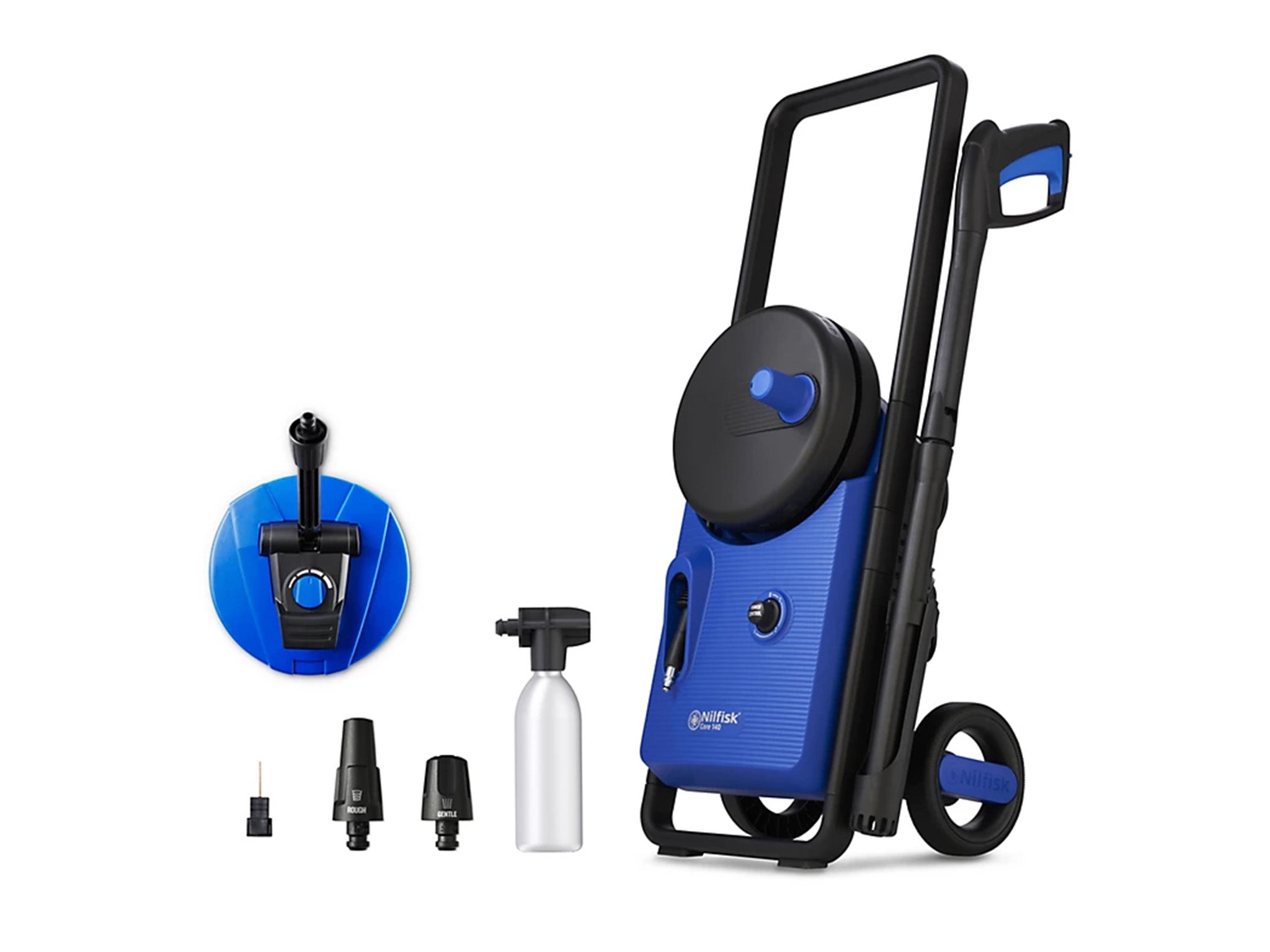
- Best: Budget pressure washer
- Hose line length: 6m
- Max pressure : 140bar
- Flow rate: 474l/hr
- Power cable: 5m
- Weight: 8.7kg
- Attachments : Gentle nozzle, rough nozzle, nozzle cleaning tool, gun & lance, patio cleaner and foam sprayer
If you want to eliminate the bulk when wielding your washer then Danish brand Nilfisk has done a great job at designing a slim machine that still manages to pack quite a punch. Maxing out at 140bar, this is more than enough to get rid of grime clinging to any surface and complete a range of heavy duty tasks. Plus, there are three power settings, which can be adjusted via a dial on the body of the machine, giving you more than enough control over your jet.
The C140 comes with two nozzle attachments (rough and gentle) which are fixed to the gun according to the difficulty of the job at hand, but what we really liked about the C140 was the ultraflex hose which allowed us to work easily in tight spots. Also, it was one of the quietest machines on test, so if we needed to get a head start on our job list and fire up the machine at 9am we wouldn’t upset the neighbours (too much).
Karcher K5 power control car and home

- Best: For the car
- Hose line length: 10m
- Max pressure : 145bar
- Flow rate : 500l/h
- Power cable : 5m
- Weight: 20kg
- Attachments : T5 surface cleaner, stone and façade cleaner, Rotating washing car brush
If your pressure washing goals are a little less ambitious this spring and summer then the K5 pushes out its jet at a very useful 145bar. It has a flow rate of 500l/hr, so it’s more than a match for any task you might have around the home, even cement driveways and sidings. It retains the incredibly useful control panel on the gun that we also loved on the K7 premium (£549.99, Kaercher.com), so total control over the power and focus of the jet is within a thumb’s reach.
The gun and lance clip into the front of the machine and the hose and power cable wrap around the back, so the cable management isn’t quite as tidy as the K7, but it’s more than adequate for keeping it all in check. When using the rotary nozzle, the flow of water perhaps isn’t as targeted as with some other machines, so it might take a few passes in order to get rid of particularly stubborn staining. But when it comes to turning its talents on to our vehicle it excelled and produced a clean that a pro car wash would be proud of, without us having to fumble around with any tokens.
Plus, the fact that you can toggle between power outputs from the gun means you can go from windscreen, to panelling, to rims without having to continually make adjustments on the body of the machine.
Stihl RE 130 plus

- Best: Build quality
- Hose line length: 9m
- Max pressure : 135bar
- Flow rate : 500L/H
- Power cable: 5m
- Weight: 21.2kg
- Attachements: Detergent spray bottle, surface cleaner
If you know your washer is going to take a bit of a beating in the course of its duties around your home then the RE 130 plus is definitely the one for you. It’s built to last with solid, easy-rolling wheels, steel reinforced hose and plenty of bumpers and fenders to keep it operational. It spits out its water jet at a very respectable 135 bar and the fact that you can toggle between different power settings from the handle without going back to the main machine, means that you can clean cars and other objects that require different pressures of water depending on the area you’re working on. The soft-grip handle of the lance is well designed and was one of the most comfortable to work with on test.
Stihl has really thought about cable management too with a built-in hose reel that sits on top of the machine. It’s easily reeled in and out via a hose guide that stops it snagging, although we did find the hose itself a little unwieldy and not quite as easy to work with as some of the other hoses in the line-up. However, there was never any danger of it kinking and interrupting the flow, which can get up to 500l/h when the machine is maxed out. Storage for the 5m cable was equally straightforward and the lance itself detaches from the hose and is stored in the body of the machine.
There’s a detergent bottle that attaches to the lance for jobs like cleaning the car, as well as an interchangeable fan jet and rotary nozzles for bigger jobs involving more stubborn dirt.
Hyundai HYW3000P2
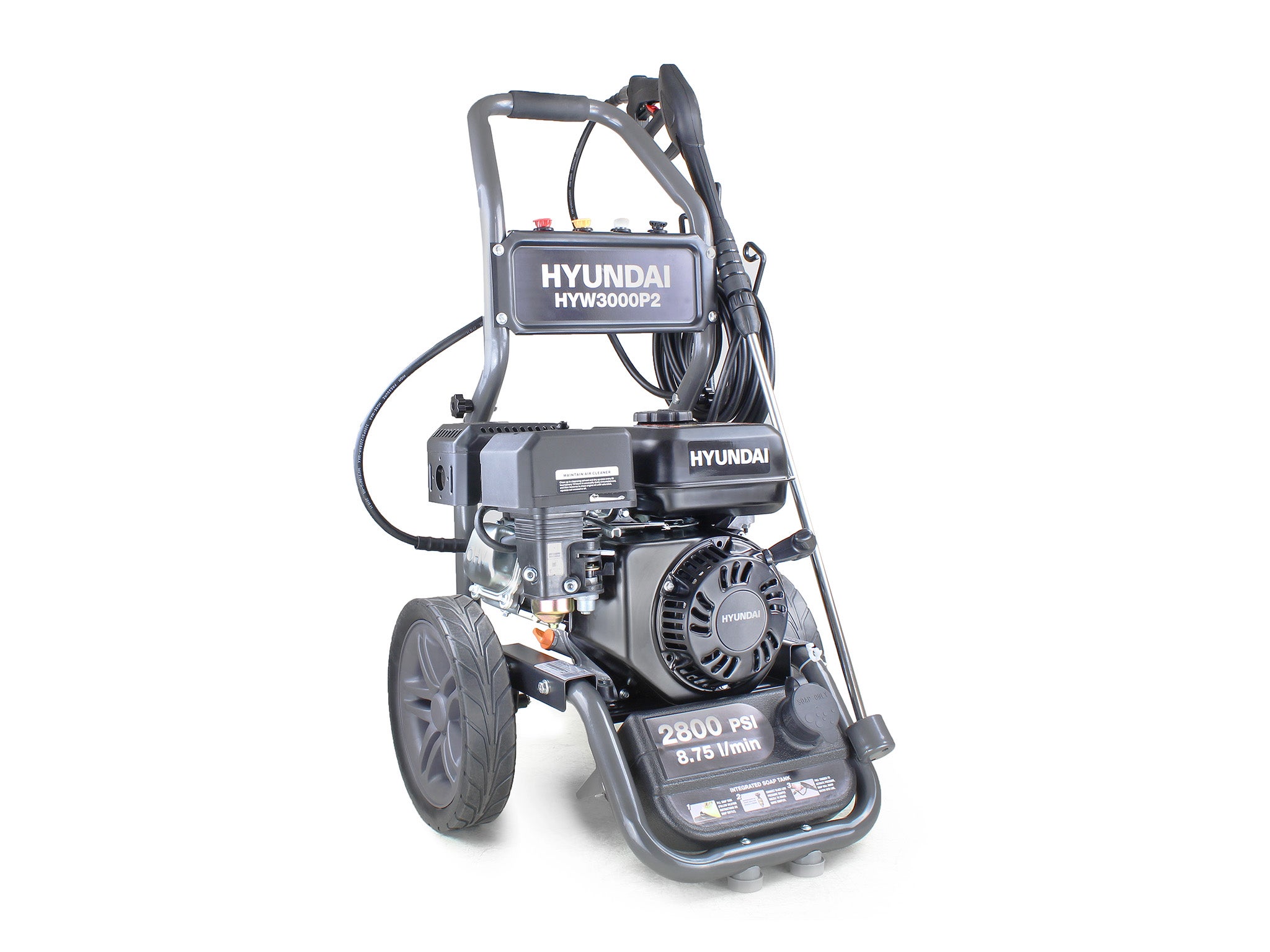
- Best: Petrol-powered washer
- Hose line length: 7.5m
- Max pressure : 193 bar
- Flow rate : 525l/h
- Power cable: N/A
- Weight: 31.89kg
- Attachments : 3 vari-angle nozzles and a soaper nozzle
The advantages of petrol powered machines is that they tend to be very powerful, portable and there’s one less cord to worry about while you’re working. Often seen in action hosing down tractors and big machinery they still have their uses around the home if you have a lot of concrete, sidings, stucco or render to clean on a regular basis.
The Hyundai delivers a whopping 193bar from its 210cc four stroke engine, which is surprisingly quiet compared to the other petrol machines we tested. It also out performed these machines and its three quick release nozzles (which control the 0, 15, and 40-degree angle of spray) makes it an incredibly versatile machine. That’s even more true when you include the integrated 3l soap tank that just needs the low pressure soaper nozzle attached to enable the soap to be drawn into the line for an instant jet wash. All these colour coded nozzles are stored neatly within the body of the machine too.
Huge puncture proof wheels, a steel frame and anti-vibration feet for when the machine is working make it an absolute doddle to get around to the most inaccessible parts of a property and the Hyundai started well every time and was comfortable to use. The only issues that stopped the washer getting full marks is the fact that the oil is a little tricky to access as it’s located under the engine and, even though it’s quiet for a petrol machine it is noisy in comparison with electric washers.
Ryobi RY170PWA
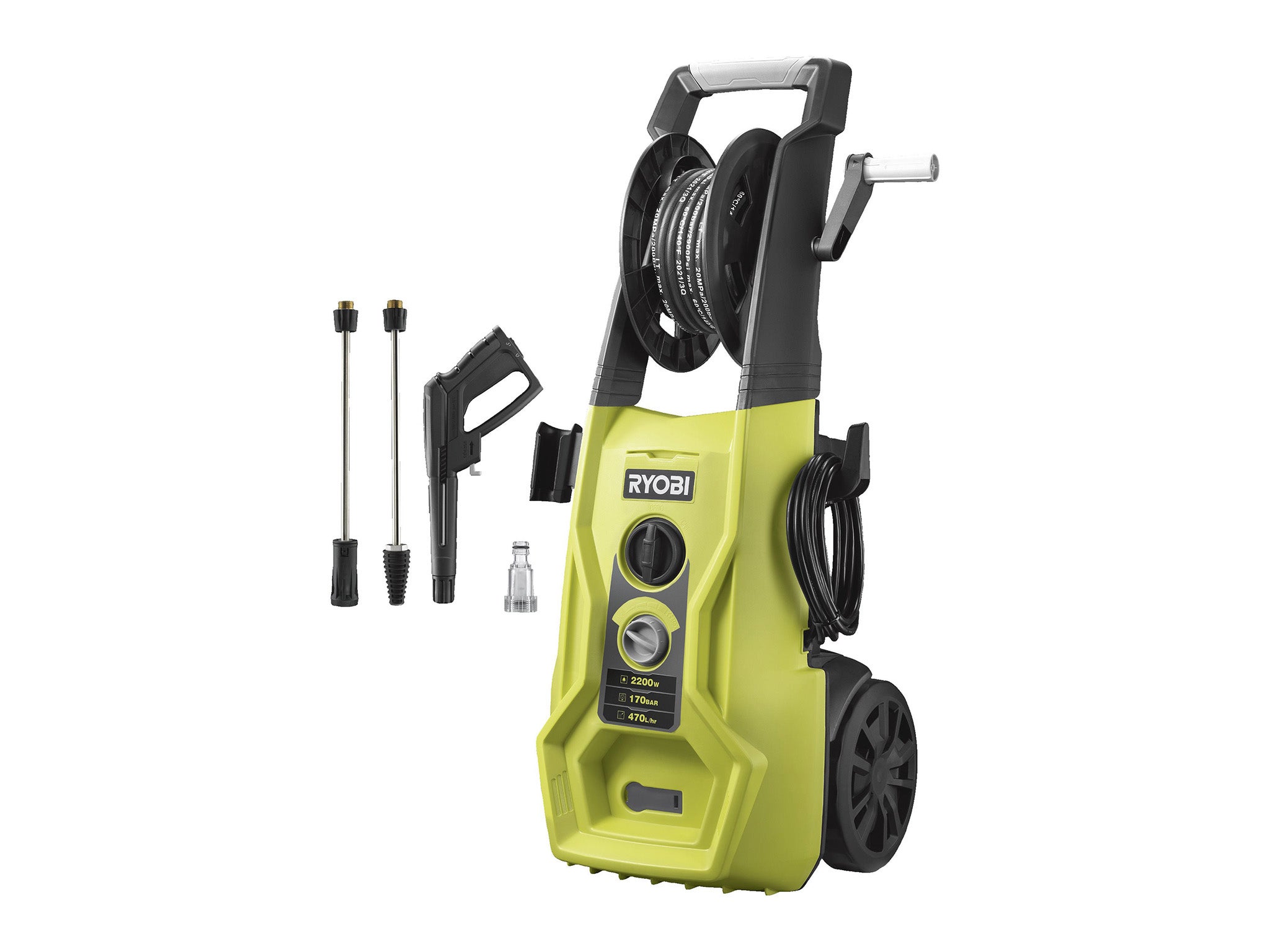
- Best: For driveways
- Hose line length: 10m
- Max pressure : 170bar
- Flow rate : 470l/hr
- Power cable : 5m
- Weight: 24kg
- Attachments : Vario lance, turbo lance
This 170bar washer has a variable power setting dial that is controlled from the machine itself which makes it a good choice for jobs that require prolonged power at one setting like grubby driveways or garden stonework. Ryobi has clearly given some thought to the cable management system too, which, quite literally, revolves around a spool and crank suspended within the handle and we had no problem with any kinking from the steel-braided hose during washing. There’s also an integrated 1.2l soap tank for cars or wheelie bin cleaning and the machine wasn’t too heavy to move around. Plus, the whole unit stayed stable even when we were washing at full power.
Worx 20V nitro hydroshot WG633E
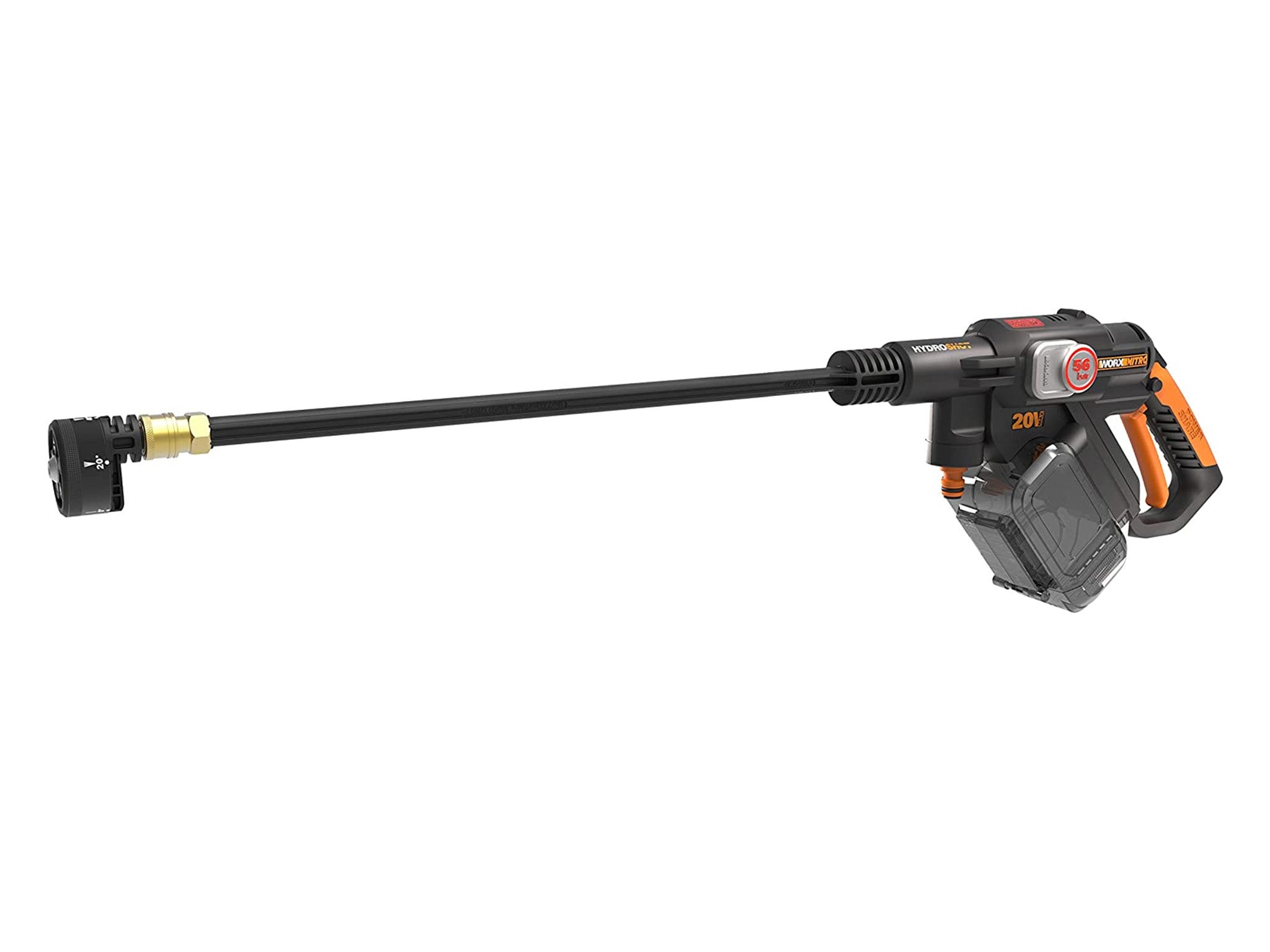
- Best: For camp site cleaning
- Hose line length: N/A
- Max pressure : 56bar
- Flow rate : 200l/h
- Power cable : N/A
- Weight: 2.2kg
- Attachments : Water bottle adapter
You won’t have to worry about any cable management with this 56bar handheld washer, which is an absolute doddle to set up and relies on a 6m hose so that it can draw from any source, from a butte to a bucket. This makes it perfect for those periods of time that you’re away from a power source but still need to keep cars, bikes, tents and caravans spic and span.
There are five different spray patterns that you toggle between from the nozzle and the nice, long lance keeps you well away from any spray. And though we did occasionally experience little dips in the jet power, perhaps as a result of the battery power, this is a minor niggle as they lasted only a second.
We really liked the ingenuity of this washer and were further impressed by the water bottle adapter, which means that you can fit almost any 2l bottle of water to the washer, which is perfect, again, for base camp cleaning or if you just want to up the ante for your next campsite water fight. The price includes the battery and charger, but if you already have other Worx tools within their battery ecosystem the bare tool is £129.99.
Bosch universal aquatak 125
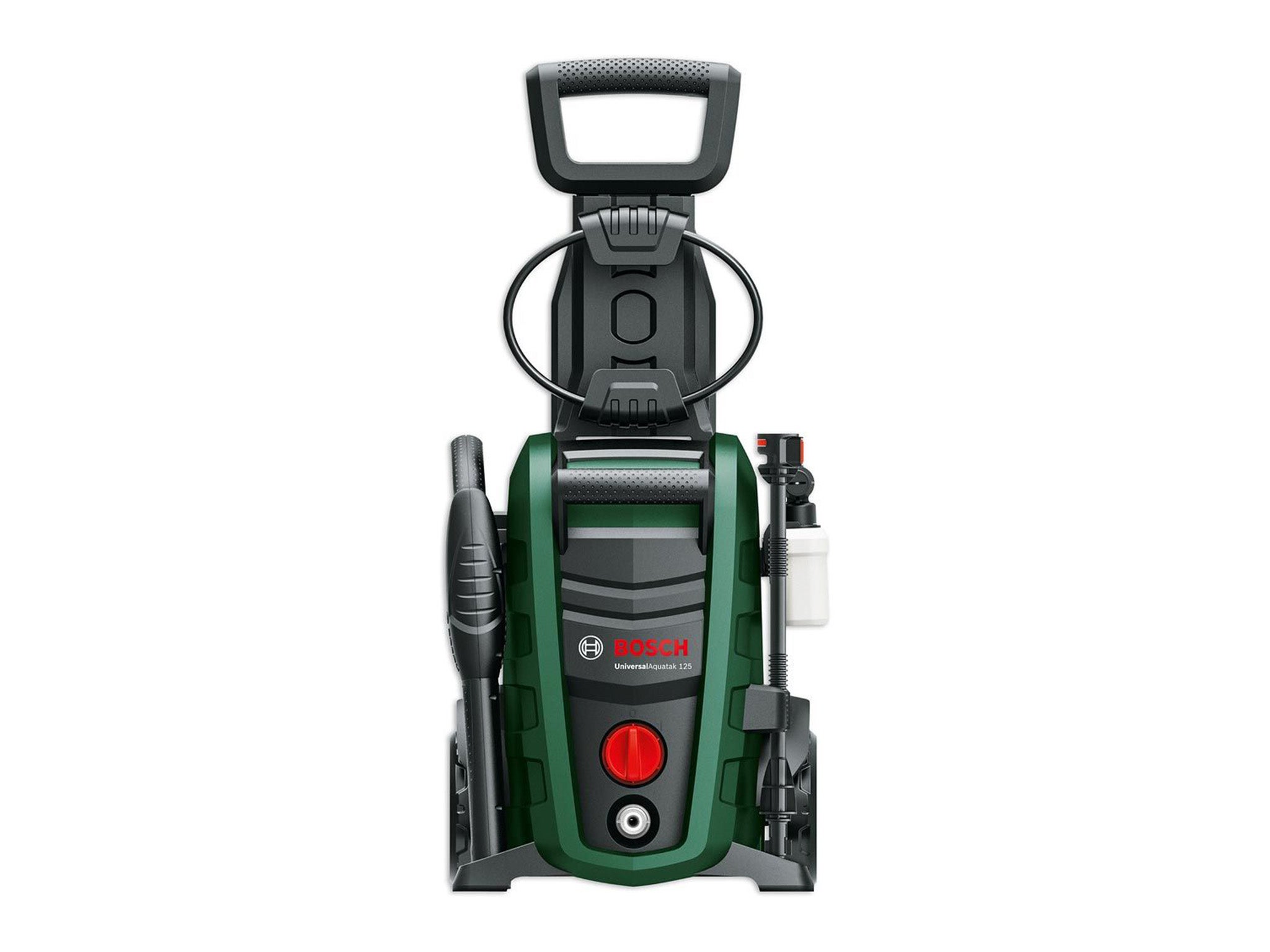
- Best: For medium duty work
- Hose line length: 5m
- Max pressure : 125bar
- Flow rate : 360l/h
- Power cable : 5m
- Weight: 6.4kg
- Attachments : High pressure detergent nozzle, 450 ml
From the entire Bosch aquatak range, this is the one that we think offers the most. It’s perfect for households that need a pressure washer that can deal with a range of domestic cleaning tasks such as refreshing the patio, cleaning the car, or clearing out the guttering, quicker than you can say “hose pipe ban”. The lighter weight of the unit – added to the fact that you can store the gun back in its holster while the machine is still on, so you can wheel it to another position – really adds to the excellent portability of the machine served by large, easy-rolling plastic wheels.
The nozzle wasn’t stiff to move and selection of the three settings (fan, rotary and pencil) was easy so that you could focus the jet according to how hard you needed the water to impact the surface in front of you. The 450ml high-pressure foam nozzle performed particularly well and did a great job of getting grime and dust off the car before further rinsing. You don’t need to buy any proprietary detergent, just fill the nozzle’s reservoir and away you go.
This is also a great machine if you really need to keep the peace with everyone else on your street, as it’s the quietest machine we tested, but still has just enough power to deliver pressure levels that can get a range of jobs done. The aquatak’s adjustability also means that the handle, hose, gun and detergent nozzle are all stored or retracted into the machine so it can be stored on racking or shelves if necessary.
Muc-Off pressure washer starter kit
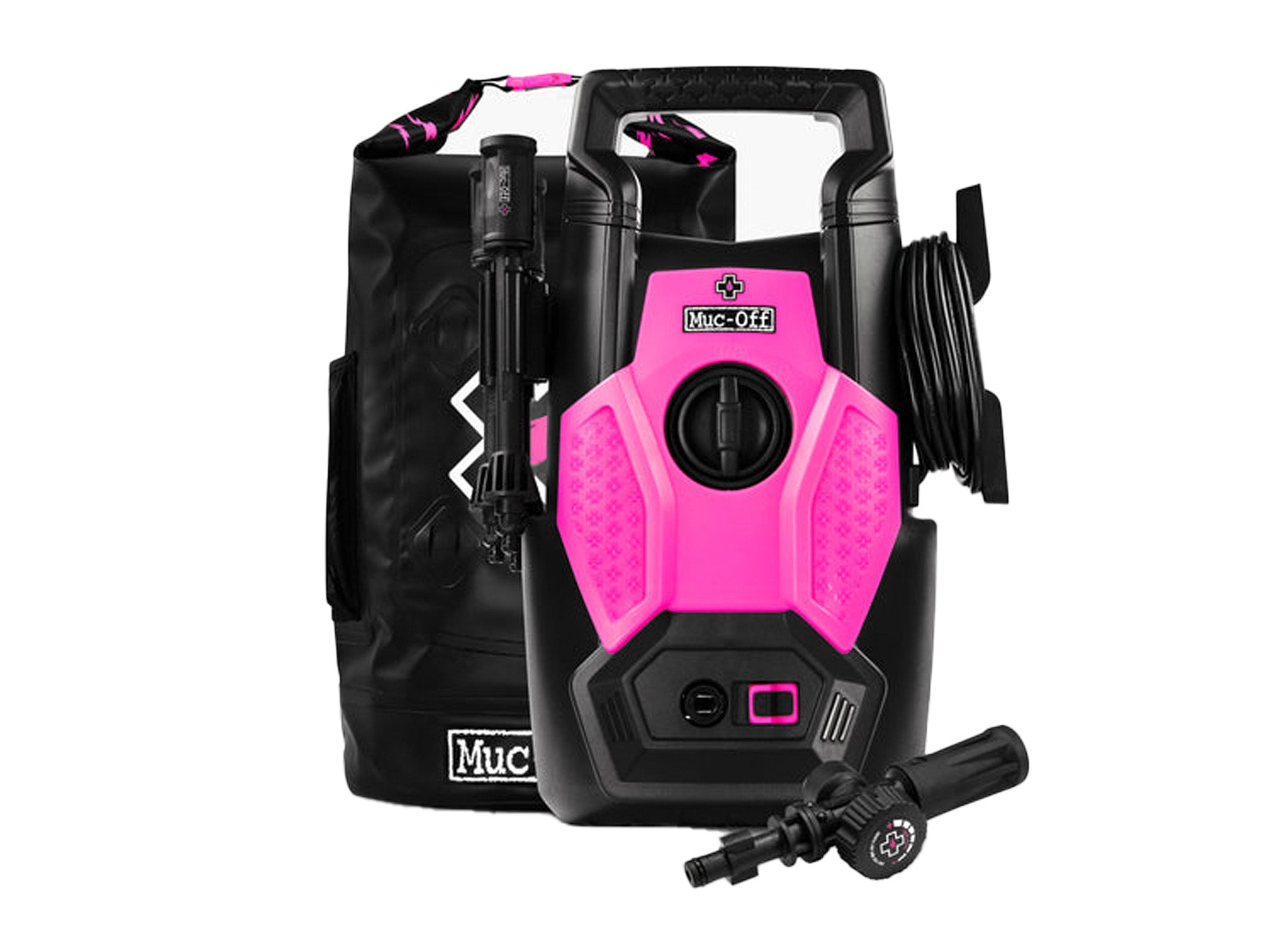
- Best: For bikes
- Hose line length: 5m
- Max pressure : 100bar
- Flow rate : 390l/h
- Power cable : 5m
- Weight: 6.2kg
- Attachments : Snow foam lance, bicycle cleaning lance, motorcycle cleaning lance, adjustable cleaning lance
If you’ve already got a general household washer and you’ve got plenty of bikes to maintain then this portable device is really worth considering, because it has been made with two wheels in mind. That means the three lances included in the kit have been specifically designed to stop water getting into bearings and suspension parts, while still ensuring enough power to get your bike looking fresh again, without damaging surfaces and other components.
You’ll have loads of fun with the snow foam lance which allows the attachment of one of Muc-Offs range of detergents to cover your bike in a very satisfying soapy blanket. Meanwhile, the adjustable lance allows you to control the amount of foam going on to the bike, via a dial top-mounted on the lance. The attention to detail continues with the fact that all the lances have a soft touch finish to make sure if you get too close to the frame, it’s not going to scratch paintwork.
It’s the little things that make this washer a must-own for bikers who regularly get down and dirty with their rides. And when you’re finished, everything fits into a custom waterproof dry bag carry case for easy storage, too.
Pressure washers FAQs
What is a pressure washer?
A pressure washer (often referred to as a power washer) uses a high-pressure jet of water to clean a wide range of items, including patios, garden furniture and cars.
What can you use a pressure washer for?
Pressure washers can clean everything from decking, garden furniture and fencing, right through to vehicles, exterior paintwork, swimming pools, gutting and patios - while heavy duty machines can even clean large paths, driveways and stonework. A good machine should remove stubborn dirt and grime, mould, loose paint and even chewing gum.
How does a pressure washer work?
Pressure washers are mains-powered, and they also connect to a garden hose. In a nutshell? They’re water pumps powered by an electric motor. The water comes out of a part which is commonly described as either a nozzle or a wand. Pressure washers will usually come with different adaptors. These will typically be different, smaller nozzles which fit onto the end of the wand, or entire wands which can be easily attached and removed. These wands are often referred to as lances.
What type of pressure washer should I get (petrol or electric)?
Most pressure washers are electric, corded machines that run off mains electricity. They are quiet, affordable and easy to use. Petrol powered pressure washers are more powerful and expensive, making them more suitable for heavy-duty jobs and working away from home. They lack annoying cables but will need constantly topping up with fuel.
Are pressure washers bad for your car?
Most pressure washers can be used to clean cars – even prized motors with pristine paint jobs. This is because the average pressure washer will come with several attachments, and will have controls which allow users to alter the power of the water jet.
“Most pressure washers can be used on vehicles, but you should always carefully follow the manufacturer’s guidance and advice,” says Paul Hicks, product and marketing manager at Stihl, one of the top pressure washer brands. “Always keep the water jet a reasonable distance from the car to avoid damage and consider using a dedicated cleaning solution to help remove the dirt from the car too.”
The best pressure washer features to look for
Pressure
If you’re going to be using your pressure washer on a wide range of surfaces, you’ll want one with settings which allow you to quickly tweak the water pressure, while multiple fixtures – such as pressure washer brushes designed specifically for patios – will come in handy, too.
“Two of the main things to consider when choosing a pressure washer is the water pressure and flow rate,” says Stihl’s Paul Hicks. “Look out for a pressure washer that provides both good pressure and a high water flow rate. It’s easy to get high pressure, but the holy grail is a combination of a high pressure and a high flow rate.”
Light duty machines are up to 100 bar, which is good for decking, fences and garden furniture. Mid-range machines are 110 to 130 bar – these can also tackle vehicles, exterior paintwork, guttering and small patios and driveways. Heavy duty machines are 130+ bar – these are more suited to large areas, plus stonework and really grubby 4x4s or caravans.
Length of hose
It’s also worth taking a second to consider how the pressure washer will attach to your water source. “Make sure the washer can be connected to a standard hose or includes a syphoning kit suitable for any fresh water source,” says a spokesperson at Ryobi, another leading pressure washer manufacturer. “And make sure the washer is portable. This will allow you to clean on the go anytime, anywhere.”
Accessories
All machines come with a standard spray head, but some come with added extras, including:
- Specialist brushes (for cars and bikes, for example)
- Specialist lance (most come with a basic one, but you can get others for different surfaces)
- Patio cleaners (concentrates the power into a small area)
- Foam nozzle (a handy way of applying detergent – great for vertical surfaces like cars)
- On-board detergent tank that you can pre-fill with a cleaner of your choice
- Professional hose (adds length to your water supply hose)
Auto start/stop
Pressure washers with this feature use the trigger on the spray gun, as opposed to a switch on the main machine, to start and stop the flow or water. This can save quite a bit of water, especially for more fiddly jobs that don’t require a constant flow of water.
Storage
If space is at a premium, look for more compact machines with integrated storage, especially for cables and hose reel.
How to care for your pressure washer
In the same way you drain a hose before storing it, make sure you drain any excess water from the hose after using the pressure washer. Storage is important, too. “Always make sure you hang your pressure washer gun and hose so that the water will drain out of them,” says a Ryobi spokesperson. “It’s also important to avoid storing it in an area where temperatures will get below freezing level.
The verdict: Pressure washers
Although it wasn’t the most powerful machine in the edit, the Husqvarna PW 130 is more than capable of turning its high-pressure hose to a variety of cleaning jobs around your property, whether that’s cleaning mud from work tools, getting rid of garden furniture grime, or taking on the bigger jobs like decking, patios and driveways. Intuitive to use and easy to work with in terms of hose, cabling and stability it’s more than capable of sprucing up tired areas, boasts excellent build quality and is one of the most lightweight and compact pressure washers we tested. Well priced, the machine is easily carried from job to job and designed to fit on a shelf in the shed or racking in the garage once the job’s done.
Let the gadgets do the work for you – read our reviews of the best robot lawnmowers and the robot vacuums
Breeze through your home DIY projects with the best cordless drills
